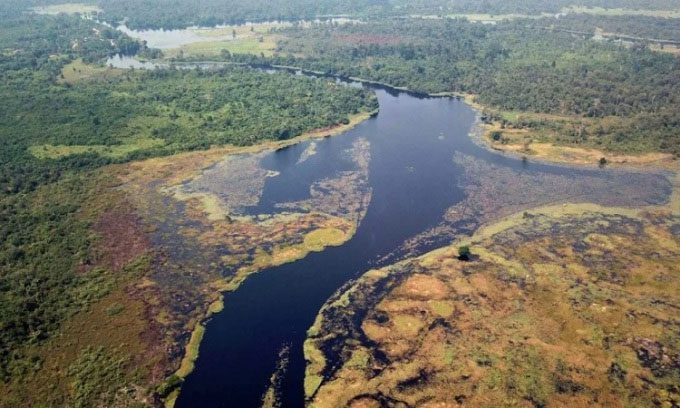The Ruki River contains so many dissolved organic compounds that it appears darker than the Rio Negro flowing through the Amazon rainforest.
The Ruki River is about 0.5 km wide at its mouth and has a much larger average flow rate compared to the Rhine River, yet very few people outside of Africa have heard of this river. For those living along its banks, its color seems quite normal, but researchers from ETH Zurich were astonished upon seeing the river’s water color and sought to uncover the reasons behind its deep dark hue.

The Ruki River from above. (Photo: Matti Barthel / ETH Zurich)
“We were extremely surprised by the river’s water color,” Dr. Travis Drake shared. Many rivers are dark enough to be labeled as “black water.” One of the largest tributaries of the Amazon River, the fifth-largest river in the world by discharge, is called Rio Negro (Black River) due to organic material that darkens its waters. However, the Ruki River stands out among them.
Like many other blackwater rivers, the color of the Ruki comes from dissolved organic compounds (DOC) in the water. The lack of sediment also contributes to its coloration. While the soil often darkens the clear waters flowing from the mountains, it rarely becomes pitch black like the materials found in tropical rainforests, which impart the distinctive color to the Ruki. The Ruki flows over a nearly flat surface, so it does not accumulate much sediment. The research findings on the river were published in the journal Limnology and Oceanography, as reported by IFL Science on October 19.
On the other hand, heavy rainfall in the region washes DOC from the vegetation on the forest floor. During the rainy season, the flat surface causes large areas to flood for weeks, leaking even more compounds. Noticing that there was no scientific explanation for why the Ruki River is darker than other rivers flowing through the tropical rainforest, Drake and his team decided to seek answers. They established a monitoring station to explore the chemical composition of the river before it flows into the Congo River. The research team employed on-site measurement methods as there is no power supply in the area.
The researchers could measure the density and dating of the DOC in the water to determine whether it originated from peat swamps along the riverbank. These swamps retain a massive amount of undecomposed plant material. Currently, this process transforms the area into a carbon sink. However, if the carbon in the swamps escapes and is released into the atmosphere, it could contribute to global warming. The carbon dating results from the research team indicated that this almost never occurs.
Drake and his colleagues found that the Ruki River has DOC concentrations per liter that are four times higher than those of the Congo River and 1.5 times higher than the Rio Negro. Although the river is rich in organic acids that can dissolve carbonates and release carbon dioxide, this does not happen at a concerning level. The river is very calm, and when the river water is saturated with carbon dioxide (CO2), this gas cannot easily escape, preventing the formation of additional CO2.


















































